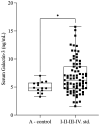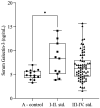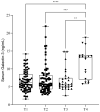Alteration of Serum Gal-3 Levels in Endometrium-Related Reproductive Disorders
- PMID: 40004091
- PMCID: PMC11855016
- DOI: 10.3390/ijms26041630
Alteration of Serum Gal-3 Levels in Endometrium-Related Reproductive Disorders
Abstract
Endometriosis, a benign, chronic gynecological disorder characterized by the presence of endometrial-like tissue outside the uterine cavity, affects 15% of women of reproductive age. Galectins, a family of beta-galactoside-binding proteins, regulate inflammation and autoimmunity and are widely expressed in reproductive tissues. This study aimed to assess Galectin-3 (Gal-3) levels in the serum of patients with endometriosis compared to asymptomatic controls and investigate serum Gal-3 level changes over a one-year follow-up period of patients with endometriosis. To determine the levels of soluble Gal-3 in the serum of women with endometriosis or gynecological tumors as well as healthy controls, a human Gal-3-specific ELISA was used. Our findings revealed significantly elevated serum Gal-3 levels in patients with endometriosis compared with healthy controls. Furthermore, Gal-3 concentrations were markedly higher in patients with malignant gynecological transformation of the endometrium than in patients with or without endometriosis. During the one-year follow-up, patients with endometriosis exhibited a progressive increase in serum Gal-3 levels. These findings highlight the potential of Gal-3 as a biomarker for endometriosis and related gynecological conditions. However, further prospective studies with larger, more representative patient cohorts are needed to validate its clinical value.
Keywords: endometriosis; galectin; non-invasive diagnosis.
Conflict of interest statement
The authors declare that they have no known competing financial interests or personal relationships that could have appeared to influence the work reported in this paper.
Figures







References
-
- Canis M., Donnez J.G., Guzick D.S., Halme J.K., Rock J.A., Schenken R.S., Vernon M.W. Revised American Society for Reproductive Medicine classification of endometriosis: 1996. Fertil. Steril. 1997;67:817–821. - PubMed
-
- Vergetaki A., Jeschke U., Vrekoussis T., Taliouri E., Sabatini L., Papakonstanti E.A., Makrigiannakis A. Galectin-1 overexpression in endometriosis and its regulation by neuropeptides (CRH, UCN) indicating its important role in reproduction and inflammation. PLoS ONE. 2014;9:12. doi: 10.1371/journal.pone.0114229. - DOI - PMC - PubMed
MeSH terms
Substances
LinkOut - more resources
Full Text Sources
Medical

